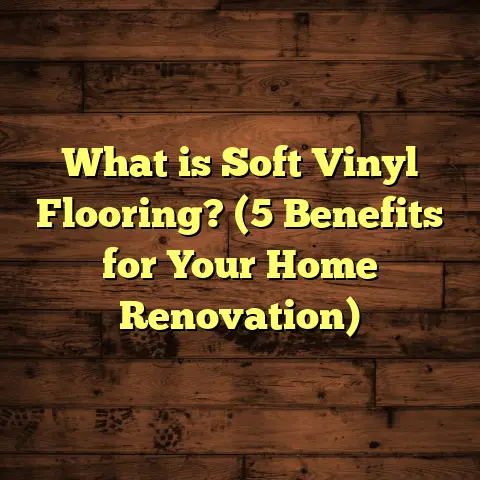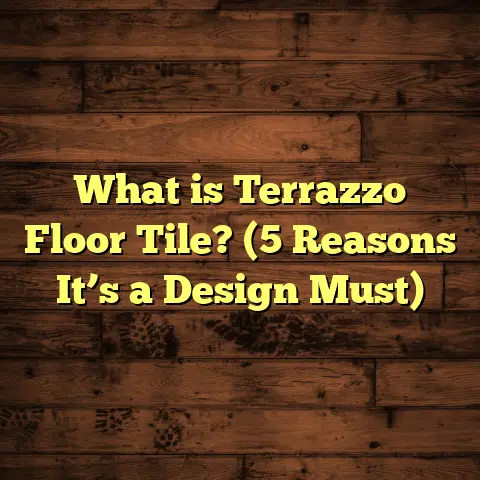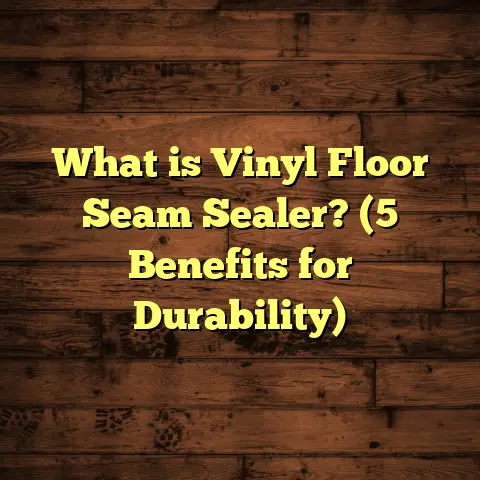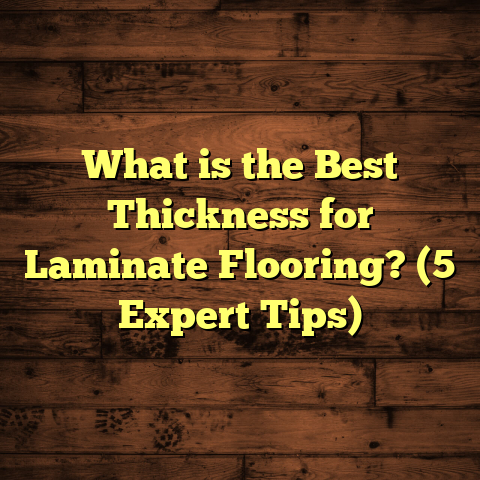What is VCT Flooring? (5 Benefits & Stunning Visuals Inside!)
Imagine you’re standing in a busy commercial space—maybe a school hallway, a hospital lobby, or a retail store. The floor beneath your feet needs to be tough, easy to clean, and visually appealing. Have you ever wondered what kind of flooring can handle that kind of traffic day after day without losing its charm? That’s where VCT flooring comes into play. I’ve worked with VCT for years, and I’m excited to share all about it, including some benefits and visuals that might just surprise you.
What Is VCT Flooring?
VCT stands for Vinyl Composition Tile. These tiles are made from a mixture of natural limestone, filler materials, thermoplastic binder, and color pigments. What makes VCT unique is its composition—it’s a resilient flooring option designed to withstand heavy foot traffic while offering a range of design possibilities.
Unlike traditional vinyl sheet flooring, VCT comes in individual tiles, usually 12×12 inches, which are installed in a pattern. This modular nature makes it easier to replace damaged tiles without tearing up the entire floor.
VCT has been around since the 1950s, initially popular in schools and hospitals due to its durability and cost-effectiveness. Over the years, it’s evolved with better manufacturing techniques and finishes that improve both aesthetics and performance.
One thing I love about VCT is how it strikes a balance between practicality and design. It’s not flashy like marble or hardwood, but it’s reliable and can be surprisingly stylish. You can find VCT tiles in solid colors or patterned varieties that mimic stone or terrazzo looks. For spaces that demand hard-wearing floors without breaking the bank, this material has no equal.
What Makes VCT Different From Other Flooring Types?
It’s easy to confuse VCT with other resilient flooring options like luxury vinyl tile (LVT) or vinyl sheet flooring. But here’s the difference: VCT is made mostly from natural materials combined with vinyl binders, while LVT is primarily vinyl with photographic layers to simulate wood or stone.
VCT’s surface is designed for waxing and polishing, which lets you build a protective layer that enhances durability and shine over time. LVT usually comes with a factory finish that doesn’t require waxing.
Compared to hardwood or tile, VCT has superior resistance to moisture and impact damage. It’s also softer underfoot than ceramic tiles, reducing fatigue for people who spend long hours standing.
Why Choose VCT? Five Benefits That Make It Stand Out
1. Durability That Lasts for Years
From my experience working on commercial projects, durability is one of the biggest reasons clients opt for VCT. These tiles handle heavy foot traffic like a champ. In fact, VCT can last up to 20 years if maintained properly. Did you know that some schools I worked with had VCT floors that went strong for over 15 years before needing any major work?
The secret lies in its composition and installation method. Once installed with the right adhesive and sealed with multiple coats of floor finish, VCT becomes highly resistant to scratches and scuffs.
I remember working on a hospital project where the corridors were packed 24/7 with patients, staff, and equipment carts. The VCT floors showed minimal wear even after several years, thanks to regular maintenance and proper finishing.
Durability also means VCT can withstand heavy rolling loads like carts or wheelchairs without cracking or denting—a big plus for medical facilities and warehouses.
2. Cost-Effective Flooring Solution
If you’re budgeting for flooring, VCT is an economical choice. I remember a project where the client wanted a durable floor but had a tight budget. After running numbers through FloorTally—a tool I use regularly to estimate material and labor costs—we found that VCT offered the best balance between upfront costs and long-term value.
VCT tiles themselves are generally cheaper than hardwood or luxury vinyl planks. Plus, since damaged tiles can be replaced individually, you don’t have to spend big money on full-floor repairs.
To give you an idea:
- The average cost per square foot for installed VCT ranges from $2 to $5.
- Hardwood flooring often starts at $8 per square foot installed.
- Luxury vinyl tile typically falls between $3 and $7 per square foot.
Over the life of the floor, maintenance costs for VCT tend to be lower than carpet or wood because it requires less frequent replacement.
3. Customizable Aesthetics
VCT isn’t just practical; it’s versatile design-wise too. The tiles come in a wide range of colors, patterns, and textures. You can create checkerboard patterns, intricate mosaics, or simple solid-color layouts depending on your style.
One of my favorite projects was for a community center where we mixed bright red and blue VCT tiles to create an eye-catching floor pattern reflecting the organization’s colors. It gave the space personality without sacrificing durability.
Custom patterns in VCT can be quite striking when done well. Some designers play with contrasting colors to create borders or geometric shapes that add visual interest without complicating maintenance.
Also worth noting is that newer VCT products include options with textures mimicking natural stone or terrazzo finishes. These bring an upscale look to commercial spaces without the cost of real stone.
4. Easy Maintenance and Repair
Cleaning VCT is straightforward—you just need regular sweeping and mopping with neutral pH cleaners. The real trick is applying floor finish coats every few months to keep the surface protected and shiny.
I’ve seen facilities that neglected maintenance struggle with dull floors or surface damage. But with routine care, VCT remains easy to maintain compared to other flooring options like carpet or hardwood.
Here’s a quick rundown based on my experience:
- Daily sweeping or dust mopping prevents dirt from scratching the surface.
- Wet mopping once or twice weekly with mild cleaners keeps floors clean.
- Every 3-6 months, apply 2-3 coats of floor finish (wax) to protect tiles.
- Deep stripping removes old finish every 2-3 years before refinishing.
- Replace cracked or damaged tiles individually when needed.
If your facility has janitorial staff familiar with these steps, maintaining VCT becomes hassle-free.
5. Eco-Friendly Choices Available
You might not expect this, but some manufacturers now produce VCT with recycled materials and low-VOC adhesives. This reduces environmental impact and improves indoor air quality—a consideration more clients are asking about these days.
During a hospital renovation I worked on recently, the client chose eco-friendly VCT products that met strict health standards while staying within budget.
Choosing green-certified products can help buildings earn LEED credits or meet WELL Building Standards focused on occupant health.
How Is VCT Installed?
Installation is pretty straightforward but requires precision for best results.
Preparing the Subfloor
The subfloor must be clean, dry, and level before laying down VCT tiles. Any bumps or cracks will show through the tiles or cause them to lift over time.
In one project I handled for a retail store, improper subfloor preparation led to bubbling tiles within months—something easily avoided with proper prep.
Before installation:
- Remove old flooring residue
- Patch holes or cracks
- Level uneven areas with self-leveling compound
- Check moisture levels (should be under 3 lbs per 1000 sq ft in 24 hrs)
Applying Adhesive
I usually recommend using a high-quality vinyl adhesive applied evenly with a notched trowel. This ensures a strong bond without gaps.
The adhesive needs time to flash off (dry partially) before laying tiles; otherwise, bubbles can form under tiles.
Some adhesives also have antimicrobial properties for healthcare settings—something worth considering depending on your space.
Laying Tiles
Tiles are laid row by row, often starting from the center of the room to maintain symmetry. It’s important to stagger seams to improve stability and appearance.
Using chalk lines helps keep rows straight. If you’re working in large spaces, expansion joints may be necessary to allow for movement caused by temperature changes.
Rolling and Sealing
Once all tiles are in place, they’re rolled with a heavy roller to secure bonding. Then several coats of floor finish go on after curing—this step protects the surface and gives that signature shine.
On bigger jobs, I always plan time for curing between coats because rushing this process leads to peeling or dull spots later.
Maintaining Your VCT Floor: Tips That Work
Maintaining VCT isn’t complicated but requires commitment. Here’s what I recommend based on years of hands-on experience:
- Daily cleaning: Sweep or dust mop to remove dirt that can scratch the surface.
- Wet mopping: Use neutral pH cleaners weekly or as needed but avoid harsh chemicals.
- Floor finish recoating: Apply new coats every 3-6 months depending on traffic.
- Deep stripping: Every few years, strip old finish completely before reapplying fresh coats.
- Spot repair: Replace damaged tiles quickly to prevent further issues.
Following this routine will keep your VCT floors looking great and extend their life significantly.
One story sticks out: A school janitor told me how much easier his job got after switching from carpeted hallways to well-maintained VCT floors. Less dirt accumulation meant less scrubbing—and that meant happier custodial staff!
My Personal Experience With VCT Flooring
I still remember my first major commercial project using VCT—the client was a local school district needing durable floors on a budget. I was skeptical at first because I’d mostly worked with hardwood and laminate before.
But after researching and testing samples, I realized how well VCT fit their needs: affordable, tough, and easy to maintain by their janitorial staff. The installation went smoothly thanks to proper prep work and adhesive choice.
Years later, visiting that school still showed me the value of choosing the right floor for the environment. The floors looked good despite heavy daily use by kids and staff alike.
Since then, I’ve worked on dozens of projects involving VCT—from hospitals to community centers—and each time it proves its worth.
Some Interesting Data Points About VCT Flooring
- According to industry reports, VCT floors can reduce maintenance costs by up to 30% compared to carpet in commercial settings.
- Studies show that properly maintained VCT can last anywhere between 15-20 years.
- The cost per square foot of installed VCT typically ranges from $2 to $5.
- Over 60% of schools in the U.S. use some form of resilient flooring like VCT due to budget and durability factors.
- Waste factor during installation usually adds an extra 10-15% material order to account for cutting mistakes and replacement needs.
- Environmental certifications like FloorScore ensure low VOC emissions from certain VCT products.
These data points align closely with what clients report experiencing in real-world applications—making it easier for me to recommend confidently.
Common Challenges With VCT Flooring and How To Solve Them
No floor is perfect—VCT has its quirks too. Here are some issues I’ve encountered along with fixes:
Surface Scratches and Scuffs
High traffic areas sometimes get scuffed despite wax coatings. Prevent this by applying additional coats of finish regularly and using mats at entrances.
Yellowing Over Time
Poor ventilation during curing or using incompatible cleaning products can cause discoloration. Stick to manufacturer-recommended finishes and cleaning solutions.
Tiles Lifting or Peeling
Usually caused by moisture under the subfloor or improper adhesive application. Test moisture levels before installation and use primers if needed.
Difficult Deep Cleaning
Old wax build-up can make floors look dull. Use proper stripping agents periodically but avoid harsh chemicals that damage tiles.
Matching Replacement Tiles
Since colors may change over time due to wear or fading, it helps to keep extra tiles from initial installation for future repairs.
Comparing VCT With Other Flooring Options
Choosing flooring often means weighing pros and cons against alternatives:
| Feature | VCT | Hardwood | Carpet | Luxury Vinyl Tile (LVT) |
|---|---|---|---|---|
| Cost | Low ($2-$5/sq ft) | High ($8+/sq ft) | Low ($3-$7/sq ft) | Moderate ($3-$7/sq ft) |
| Durability | Very High | Moderate | Low | High |
| Maintenance | Moderate (waxing needed) | Moderate (refinishing) | High (vacuuming/stain) | Low |
| Moisture Resistance | Excellent | Poor | Moderate | Excellent |
| Installation Ease | Moderate | Difficult | Easy | Easy |
| Design Variety | Moderate | High | Moderate | Very High |
| Repair | Easy (tile replacement) | Difficult | Difficult | Easy |
This table helps me explain options clearly during consultations because every project is different—sometimes hardwood makes sense for aesthetics; other times cost or durability wins out with VCT.
Environmental Impact of VCT Flooring
Sustainability is getting more attention in construction these days—and flooring isn’t exempt.
Traditional vinyl production has environmental concerns due to fossil fuel use and chemical emissions during manufacturing. However:
- Many manufacturers now include recycled content in their formulas.
- Low-VOC adhesives reduce indoor air pollution.
- Durable floors like VCT reduce landfill waste by lasting longer.
- Some brands participate in take-back programs for old tiles recycling.
When clients ask about green flooring options, I suggest looking for certifications like FloorScore or GreenGuard which indicate compliance with indoor air quality standards.
Trending Uses for VCT in Modern Projects
While schools and hospitals remain the biggest users of VCT, I’m seeing new trends:
- Office spaces opting for colorful geometric patterns to add energy.
- Retail stores choosing terrazzo-look tiles for an upscale vibe at low cost.
- Residential basements using durable VCT where moisture is an issue.
- Art studios selecting textured tiles for slip resistance combined with creativity.
One recent trend I noticed was combining VCT with other flooring types (like polished concrete). This mixed-material look offers functional zones within a space while keeping budgets manageable.
What About Safety? Is VCT Slip Resistant?
Safety matters especially in high foot traffic areas. Standard VCT has moderate slip resistance which improves when waxed correctly.
For areas prone to spills (kitchens or healthcare), you can choose textured or matte finish tiles designed for better traction.
Adding anti-slip treatments post-installation is also possible if extra grip is needed without sacrificing appearance.
How Long Does It Take To Install?
Installation time depends on room size and prep work required but here’s what I usually tell clients:
- Small residential rooms (up to 500 sq ft): 1-2 days including prep.
- Medium commercial rooms (1000-3000 sq ft): 3-5 days depending on complexity.
- Large facilities: Multiple weeks including curing time between coats.
Good scheduling means planning around other trades on site so nothing gets rushed—quality takes time!
Can You DIY Install VCT?
I’ve seen some handy homeowners try installing their own VCT floors. It’s possible if you’re comfortable handling adhesives and tile placement precisely—but there are pitfalls:
- Subfloor prep requires skill; any bumps cause future problems.
- Adhesive timing matters; too wet or too dry leads to bubbles or loose tiles.
- Rolling after installation needs a heavy roller that’s hard to rent cheaply.
- Wax application requires equipment and experience for best results.
If you’re confident in your skills and have guidance from manufacturer instructions or tutorials, DIY might save money. Otherwise hiring pros ensures longevity without headaches later on.
Using FloorTally To Manage Flooring Projects Better
When estimating costs for any flooring project—including VCT—I rely heavily on FloorTally. It lets me input dimensions, select materials based on local prices, factor labor rates from various contractors, and even include waste percentages automatically.
This tool helps avoid surprises like ordering too much material or underestimating labor hours—which could delay projects or inflate budgets unexpectedly.
I’ve used FloorTally for both big commercial jobs and smaller residential installs—it adapts well across scales while giving me confidence when communicating estimates with clients upfront.
Case Study: Revamping a Community Center Floor With VCT
A few years ago, I worked on renovating a community center’s main hall floor. The old carpet was worn out, stained, and hard to clean—definitely not ideal for their busy schedule.
We decided on a bold pattern using red, blue, and beige VCT tiles arranged in geometric designs matching their branding colors. The installation took about two weeks including prep work.
Post-installation feedback was fantastic: staff loved how easy it was to keep clean; visitors commented on how vibrant the floor looked; maintenance costs dropped significantly compared to carpet before.
This project showed me how functional doesn’t have to mean boring when it comes to flooring.
Can You Use VCT Flooring in Residential Spaces?
While VCT is most common in commercial settings due to its durability and cost profile, some homeowners choose it for basements, laundry rooms, or garages where toughness matters more than luxury feel.
If you want low-maintenance floors that handle wear without breaking the bank—and don’t mind the slightly industrial look—VCT can be a smart choice at home too.
One friend of mine installed it in his basement workshop; he loves how easy it is to clean up spills from paint or oil compared to concrete alone.
Frequently Asked Questions About VCT Flooring
Q: Does VCT require waxing?
Yes! Waxing protects the surface from scratches and dullness. Regular waxing every few months keeps floors looking polished longer.
Q: How long does a typical VCT floor last?
With good maintenance including waxing/stripping cycles, floors can last from 15 up to 20 years easily in commercial environments.
Q: Can I install over existing flooring?
It depends on what’s underneath. You need a flat stable surface; old carpet must be removed entirely before installing VCT tiles safely.
Q: Is it waterproof?
VCT itself resists moisture well but seams can allow water penetration if not sealed properly—best avoided in wet areas without proper waterproofing underneath.
Q: How do I remove old wax?
Use specially formulated floor strippers designed for vinyl composition tile finishes—follow product instructions carefully as some chemicals are harsh.
So now you know quite a bit about Vinyl Composition Tile flooring—from what it is exactly to how it performs over time in real-world settings. Whether you’re curious about durability stats or wondering if it fits your next project budget-wise (hint: FloorTally can help), this material continues proving itself as an affordable workhorse in many environments worldwide.
Have you ever considered using VCT? Or maybe you’ve had experiences with it yourself? Feel free to ask if you’d like visuals or advice tailored specifically for your space—I’m happy to help!





